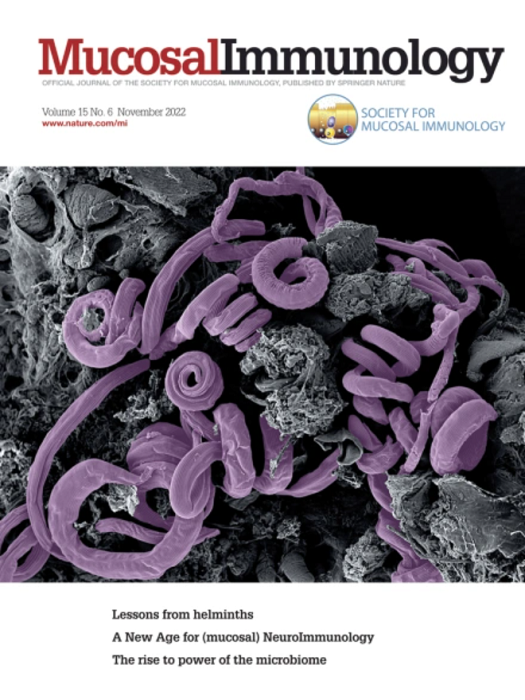诱导型而非构成型胰腺REG/ REG异构体受肠道微生物群和胰腺疾病的调节。
IF 7.6
2区 医学
Q1 IMMUNOLOGY
引用次数: 0
摘要
REG/ REG基因位点编码一个保守的强效抗菌蛋白家族,但也与胰腺炎相关。在这里,我们研究了REG/ REG家族成员是否在其基线表达水平和在胰腺和肠道中受到扰动时的调节能力方面存在差异。我们发现,在人类和小鼠中,胰腺和肠道在REG/ REG异构体水平和偏好上存在差异,其中十二指肠与胰腺最相似。胰腺腺泡细胞和肠上皮细胞是主要的REG产生细胞。肠道共生微生物在肠道和胰腺中调控相同的、选择的Reg成员的表达。这些Reg成员在转录起始位点附近具有最多的stat3结合位点,并且部分依赖于IL-22。因此,我们将它们归类为“诱导型”和其他“构成型”。事实上,在胰腺导管腺癌和胰腺炎模型中,胰腺中只有可诱导的Reg成员上调。胰腺紊乱时,肠道Reg表达保持不变,而胰腺炎在发病后不久就改变了十二指肠和粪便中的微生物组成。我们的研究揭示了REG/ REG异构体的不同使用和调节作为组织特异性先天免疫的机制,强调了胰腺和十二指肠的密切联系,并暗示肠道-胰腺通信轴导致协调的REG反应。本文章由计算机程序翻译,如有差异,请以英文原文为准。
Inducible, but not constitutive, pancreatic REG/Reg isoforms are regulated by intestinal microbiota and pancreatic diseases
The REG/Reg gene locus encodes a conserved family of potent antimicrobial but also pancreatitis-associated proteins. Here we investigated whether REG/Reg family members differ in their baseline expression levels and abilities to be regulated in the pancreas and gut upon perturbations. We found, in humans and mice, the pancreas and gut differed in REG/Reg isoform levels and preferences, with the duodenum most resembling the pancreas. Pancreatic acinar cells and intestinal enterocytes were the dominant REG producers. Intestinal symbiotic microbes regulated the expression of the same, select Reg members in gut and pancreas. These Reg members had the most STAT3-binding sites close to the transcription start sites and were partially IL-22 dependent. We thus categorized them as “inducible” and others as “constitutive”. Indeed, in pancreatic ductal adenocarcinoma and pancreatitis models, only inducible Reg members were upregulated in the pancreas. While intestinal Reg expression remained unchanged upon pancreatic perturbation, pancreatitis altered the microbial composition of the duodenum and feces shortly after disease onset. Our study reveals differential usage and regulation of REG/Reg isoforms as a mechanism for tissue-specific innate immunity, highlights the intimate connection of pancreas and duodenum, and implies a gut-to-pancreas communication axis resulting in a coordinated Reg response.
求助全文
通过发布文献求助,成功后即可免费获取论文全文。
去求助
来源期刊

Mucosal Immunology
医学-免疫学
CiteScore
16.60
自引率
3.80%
发文量
100
审稿时长
12 days
期刊介绍:
Mucosal Immunology, the official publication of the Society of Mucosal Immunology (SMI), serves as a forum for both basic and clinical scientists to discuss immunity and inflammation involving mucosal tissues. It covers gastrointestinal, pulmonary, nasopharyngeal, oral, ocular, and genitourinary immunology through original research articles, scholarly reviews, commentaries, editorials, and letters. The journal gives equal consideration to basic, translational, and clinical studies and also serves as a primary communication channel for the SMI governing board and its members, featuring society news, meeting announcements, policy discussions, and job/training opportunities advertisements.
 求助内容:
求助内容: 应助结果提醒方式:
应助结果提醒方式:


